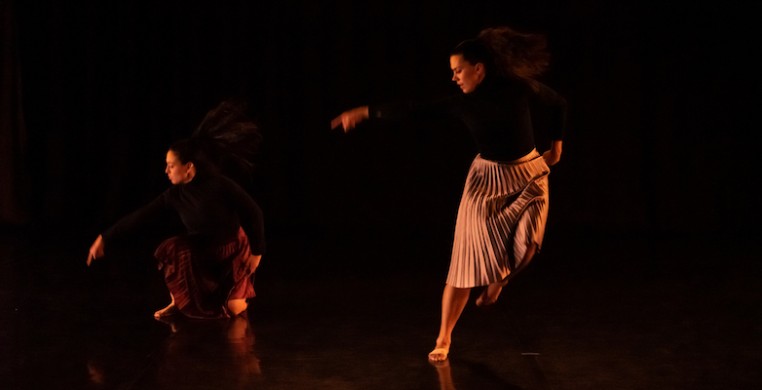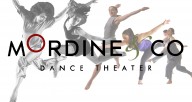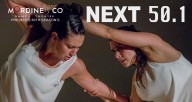In a quiet corner of Chicago’s Northwest Side, in a black box space tucked into the upstairs of an aging Chicago Park District field house, Mordine & Company Dance Theater unveiled “Next 50.1” to an intimate audience of devoted fans Thursday night. A glance inside from the lobby revealed a company of three women and two men “warming up,” quietly inhabiting the pre-performance space of Mordine’s sanctuary.
A faint echo of jazz piano trickled out the theater doors into the lobby, auditory fingers wrapping pianist Fred Simon’s alluring riffs around small clusters of chattering patrons, most of whom seemed to know each other, and drawing us to the inner sanctum of folding chairs set on risers above the expansive dance floor. As I settled into my seat in the front row, removed my coat, and extricated the tools of my trade—notepad and pen— the dancers continued doing what dancers do: wiggle and bend their bodies into a lubricated state of being. I perused the program to see what was in store, not paying much attention to what they were doing, until suddenly, I did.
Between the ambient music of Simon’s playing at the upright piano off to the side of the dance floor and the seemingly random dancers’ movements, something was clearly taking shape. That something was the superb symbiosis of improvisation that can happen only when all participants are so keenly attuned to each other’s give and take that you can’t discern which “give” came first, movement or music.
The improvisational skills at play thrust dancers and musician into a human drama of intimacy and separation, embracing and abandoning each other’s rhythms and shapes, all at an eye-grabbing level of sophistication under the ever-watchful eye of master teacher/director Mordine, who stood behind the piano, arms folded across her chest.
And just when we were thoroughly caught up in the alchemy of their interactions, they all arrived at the unspoken understanding of resolution, building a culminating group sculpture that reached beyond itself into silence. “Nice work, guys,” Mordine intoned casually, as if wrapping up just one more typical rehearsal. And so begins “Next 50.1.”
An abiding naturalness has shaped Mordine & Company’s pervasive influence. As the grande dame of Chicago modern dance, Shirley Mordine’s aesthetic of ease and flow belies its technical underpinnings. Her work has always had integrity and her dancers have always had chops, especially apparent in the current roster of company dancers.
In her guileless commentary punctuating short pauses between pieces, Mordine introduced the three distinctive works choreographed by company dancers, and the premiere of a work by frequent guest choreographer Ayako Kato, comprising the first half of the program. Each of these works, while unique in its own way, reflects Mordine’s style and influence.
Kato’s “Always the Beginning,” for full company, begins with the dancers aligned single file in a column extending upstage from the front edge of the dance floor. Set to György Ligeti’s “Etudes for Piano (14-18),” the challenging series of short studies physicalizes the music, as if the dancers were themselves the keys of the piano being played. In repeat segments, line formations expand, dispersing gradually or explosively reflecting the speed and intervals of vibrations of the piano keys. A frenetic rumble of thousands of rapid-fire notes and skittish hiccups of movement give way to quietude, coalescence and stillness, the dancers swimming through a viscous spatial environment to the piano’s single notes. The music folds and unfolds, the dancers carving ever renewing lines of breathing bodies, becoming one pulsating organism, only to roll away into the next frantic segment of reaching up and down the chromatic scale with the non-stop piano keys. The piece leads us to an enigmatic ending, the dancers seemingly suspended on the brink of their own mystery.
Company dancer Emily Stapleton’s solo, “Starting Over,” is a pensive portrait of a woman living in her past, her scarves at once mopping up a life once lived, perhaps regretted, and providing a link to what once was. Nostalgic clips of vintage song and sound effects by Alyssa Scebbi add context to a certain pathos in Stapleton’s poignant character portrait.
“After These Messages” by company dancer Nick Schrier is an acerbic commentary on branding and the physical effect of commercials on our lives. Alternating solo, ensemble, and duet segments combine to an abstraction of commercial-inspired movement vocabulary of with a tongue-in-cheek narrative contrasting Coca Cola and LaCroix. Over the top fun with undressing the fakery of branding ends the piece with a happy bunch sipping from their cans of LaCroix.
Danielle Gilmore and Melissa Pillarella’s duet “To: and From:,” set to music by The Cheiftans, uses the traditional Irish music to liberating advantage in a refreshing portrait of a relationship. A breathy ambience, attention to weight and momentum and a sense of life energy spins this duet on a lovely journey.
Two works from company repertoire by Mordine comprised the second half of the program. “Edge Mode-Part 2-Place of Refuge” (1994) combines Gregorian chant and contemporary tones in a score by Richard Woodbury, Brave Combo and Amnon Wolman. Spins and exclamations, stammers and sudden explosions define the movement, ever-shifting dynamics keeping the eye engaged.
The dancers enter in silence one at a time in “I Haven’t Heard From You” (2003). Set to Mozart’s “Sinfonia Concertante For String Orchestra,” this lyrical piece alternates unison movement and canon, with lots of breathy suspension and dance-your-heart-out freedom, showing off the dancers individual strengths. Of particular note is the lanky Austin Shirley, new to the company this year, a young dancer with poetry in his bones and springs in his feet.
Mordine’s trademark is the real deal, a uniquely personal and yet universal vision of dance that deserves to be seen by a wider audience.



